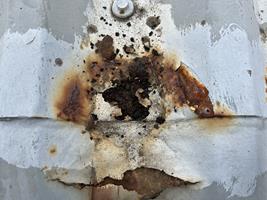Sealing Mid-Lap Roof Joints Can Cause Defects
Silicone sealants have historically been specified for sealing the horizontal gap between overlapping roof sheets when treating cut edge corrosion.
“It is how it’s always been done!”
It might seem that this is an effective solution if water ingress is suspected, perhaps because the butyl strip between the upper and lower sheets is perished, but in a large number of cases, mid-lap joints do not need to be sealed when treating cut edge corrosion.
During our independent roof surveys, we find that sealing overlapping roof sheet joints with a sealant often causes a bigger defect than the original cut edge corrosion.
The usual way of sealing overlapping roof sheet joints is to use a low modulus sealant, gunned into the mid-lap joint, then trowelled to create a “speed bump” effect that is then over-coated.
This “speed bump” effect often causes localised ponding of water and become a magnet for environmental soiling, which is why you never see a clean installation.
When the roof is trafficked, movement of the roof sheets can easily split the sealant, which then causes a capillary action, drawing water through the split which then sits trapped behind the seal.
Rust spots will eventually begin to appear through the topcoat, which is a good indicator of further corrosion occurring beneath the coating. If left long enough, the corrosion may rot the top sheet and corrode the bottom sheet too.
The bottom sheet will be protected by the original finish. There is no exposed cut edge, so it is not as vulnerable as the top sheet containing an exposed cut edge.
However, trapped moisture caused by sealants can rapidly degrade the protective coating beneath and accelerate the rate of corrosion, sometimes rendering the roof sheets irreparable.
When and How to Seal the Mid-Lap
If sealing the mid-laps with a silicone sealant is so risky, then what is the alternative?
Our building surveyors believe that the overlapping roof sheets should remain unsealed in most cases.
This allows water to enter the joint and flow out again, exactly as originally intended.
Unless corrosion is already present on the bottommost sheets, they require no treatment. As standard, Flexlap, Liquasil’s dedicated cut-edge corrosion treatment, only treats the top sheet, resulting in savings, both in terms of material cost and labour savings.
Consider – no sealant tubes to go to landfill, half the coating required and less than half the labour cost to install.
Sometimes Sealing Joints Is Necessary
Reasons why you might want to seal overlapping roof sheet joints:
- When the butyl strip has perished
- When replacing an existing failed cut-edge corrosion treatment
- When the mid-lap has perforated
- When underside corrosion is known to be present
- When a “waterproofing” solution is required
If it is felt that mid-laps need to be sealed, we prefer the use of Liquasil’s HP Butyl Tape; a geotextile-faced, 20-year waterproofing tape. This is far stronger than silicone sealants and much more flexible, allowing for the movement of roof sheets – even as they’re being trafficked.
That said, if you really want to seal the joints with a sealant, we have one available called “Lapsil.”
Specifier Beware!
Sealing overlapping roof sheet joints is a contentious issue. Sometimes it may be necessary but most of the time, it is not.
Manufacturers introduced sealants to sell more product.
But even using waterproofing tape will not necessarily solve the issues, simply because the source of the water ingress might not be from the seal. It could be from a defective roof light, condensation or even something as simple as a loose fixing.
When a mid-lap is sealed, however it is sealed, underside corrosion to occur eventually. Sealing mid-lap joints hides an existing problem.
We have sealing products to suit your preference, but unless another defect is present, sealing the joints should be avoided.


